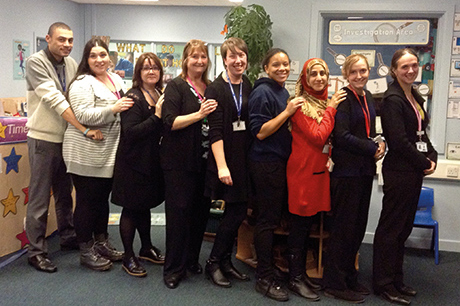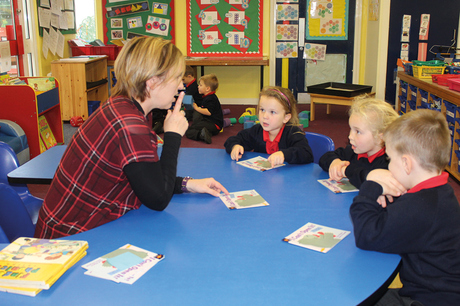
A2009 report by the Institute of Education found that, in many instances, ‘The more [teaching assistant] support pupils received, the less progress they made.’ However, there is now ‘compelling evidence’ that TAs can improve outcomes for children, according to the Education Endowment Foundation (EEF).
Its report, Making Best Use of Teaching Assistants (2015), found TAs can help children make an additional two to four months’ progress over an academic year when delivering structured interventions. The impact, though, is seen only when TAs are provided with high-quality training and support. Trust, time to liaise and working in partnership with teachers are essential if schools are to make the most of the £4bn spent annually on support staff.
CASE STUDIES
Pye Bank Primary School, Sheffield

Pye Bank Primary School is involved in a £5m EEF campaign to support Yorkshire schools to make the most of their support staff. Its integrated Foundation Stage unit combines a 52-place nursery and 60 in Reception, while its team includes four teachers, some of whom job-share, and seven TAs, some of whom are part-time.
Ofsted praised the Foundation Stage team for their ‘shared vision for the further development of the unit’ and the fact that their ‘expertise is used by the local authority in other early years settings’. One of the reasons for that is the value placed on each member of the team, says head of early years Ann Dawson.
‘Over time we have built up a real trust and strong relationship,’ she says. ‘There is a meeting at the end of every day to bring up any children or areas where there may be concerns, and there are weekly planning meetings. We are tight on communication so everyone knows what is going on. The team train together and go out for meals to build that relationship.’
TAs play a particularly important role in Reception classes, which as part of the EYFS are required to use the key-worker system. ‘Our TAs are all Level 3-qualified, so they can have a key worker group,’ says Ms Dawson. ‘TAs have around 12 in their group, teachers around 20.’
Key workers track the early learning goals of their children and oversee snack time for their group twice a week, using the time to touch base and talk about anything they have picked up through observations.
TA start times are staggered. Some arrive at 8am, some at 8.30am, so they are ready for the children when they arrive. They stay until 4.30pm on two days a week for staff and planning meetings, and 4pm on the other days.
TAs and teachers work together in planning and delivering learning. ‘The weight of the decision-making lies with the teachers,’ says Ms Dawson. ‘Planning is shared, but teachers set the objectives in line with the early years curriculum.’
The school undertakes regular enquiries to find out how they could be supporting children together more effectively. Recently the team looked at how staff were interacting with the children, and both TAs and teachers were able to make changes to their practice based on the findings. They decided to bring more ‘magic’ into the outdoor provision, and the results sum up for Ms Dawson how team-working can impact children.
‘We placed fairy doors all around the unit, and let children stumble across them,’ she says. ‘Teaching assistants and teachers were both involved in planning and delivery. The children started writing letters to whatever was behind the door, making food out of playdough, trying to be quiet so as not to wake them up. We were so excited about the outcomes; children were making links between different areas of learning. We even had one child speak who had never spoken before.’
St Mary’s Primary School, East Barnet, London
St Mary’s Church of England Primary School in East Barnet is Outstanding and was already reviewing the way it deployed its roster of TAs back in 2013 when it decided to take part in Maximising the Impact of Teaching Assistants – a training programme that grew out of the Institute of Education research findings.
Its Reception teacher works alongside a nursery nurse, whose role is considered equivalent to that of a teaching assistant, while in Year 1 the team is comprised of a teacher and TA.
‘The first thing we did was to put a stop to teaching-assistant-led interventions,’ says Maria Constantinou, deputy head. ‘We found that the same children were being taken out of the classroom for all interventions. So, we made sure that in the future we would use minimal interventions, and only those with a strong evidence base.’
Where TAs previously spent most of the time outside the classroom, now they are spending most of their time inside. Having time to discuss lessons and specific children is a must: TAs are paid to come in earlier than they used to for learning liaison time, when they can talk about the expectations in the classroom that day.
At first some teachers found it difficult to involve the TAs in the classroom, while the TAs felt at a loose end while teachers were delivering lessons. To combat this, the school created its own deployment guidance. TAs, for example, now make notes on Post-Its while the teacher is speaking, capturing key messages which can then be stuck in children’s books.
The school has set aside an annual inset day for TA training – teachers use this time for report writing.
The TAs are often the first port of call when it comes to interacting with parents; while the school employs one mealtime supervisor, the rest of the supervision is carried out by TAs. ‘They can feed back to parents whether the child had difficulties at lunchtime with food, or whether they cut up their food themselves,’ says Ms Constantinou. ‘If there was a question about a child’s learning progress, however, they would refer that to the teacher.’
Baynards Primary School, Tiptree, Essex

At Baynards Primary School, where three learning support assistants (LSAs) work alongside the teacher of its Reception class, the emphasis is firmly on ‘learning process’, rather than end product, and effective adult-child interactions.
EEF research found that TAs tended to be more concerned with getting a task finished and less concerned about developing children’s understanding, tending to close down discussion and ‘spoon feed’ answers. To raise the quality of practice at Baynards, its LSAs took part in training led by Paula Bosanquet, head of education and development at the University of East London.
‘The LSAs were given a clear language to interact with the children,’ says head teacher Nerys Maidment. ‘If children don’t understand something, the LSA can give them a prompt, and then a clue, supporting their learning without doing it for them.’
This approach, along with its emphasis on process rather than product, has been adopted by teachers and support staff alike. ‘We would use the same approach for non-academic learning – some children in Reception struggle even with putting on their coat,’ says Ms Maidment.
Initially, the team were unsure whether the approach would work. ‘When it is introduced properly, children can access it,’ says Ms Maidment. ‘We use a character called Blue, and children say, “Can you give me a Blue’s Clue?”
‘The LSAs lapped it up straight away, but the teachers had to think how they would incorporate this move from a product focus to a process focus into their planning. We all struggled at first with the difference between a prompt and a clue, for example.’
The initial training was crucial, she says. ‘There are two LSAs who weren’t here when the training happened and they are much less confident because they missed the theoretical underpinning. We needed that inspirational start to the whole process.’
MAKING BEST USE OF THE RECEPTION TEAM
• Determine the appropriate role for TAs – will they have a teaching role, with appropriate training, or will they be involved in non-pedagogical activities, such as easing teachers’ administrative workload or helping pupils to develop soft skills? This decision should be driven by the needs of pupils.
• Consider specific training for TAs on the way they interact with pupils. If Reception is following a specific pedagogy, TAs should be trained so they fully understand the principles of the approach and the techniques required to apply it.
• Teachers must have time to liaise with TAs, who should have a copy of the lesson plan ‘need to knows’ in advance.
• Consider using TAs to deliver high-quality small-group and one-to-one support using structured interventions, such as the Nuffield Early Language Intervention for four- and five-year-olds.
• Do not automatically place the children who need most help with the TAs. Responsibility for all pupils’ educational progress should lie with teachers.
• Take advice. See, for example, Career Framework and Continuing Professional Development for Teaching Assistants by National Education Trust and Unison. It profiles five levels of TA and suggests qualifications and CPD for each level, http://bit.ly/2ee1ORU.
MORE INFORMATION
• Maximising the Practice of Teaching Assistants and Maximising the Impact of Teaching Assistants, by Jonathan Sharples, Rob Webster and Peter Blatchford, http://maximisingtas.co.uk
• Professional Standards for Teaching Assistants, published by a group of organisations including Unison and NAHT, http://bit.ly/2gBqfye
• Deployment and Impact of Support Staff Project, by Peter Blatchford et al(IoE, University of London), http://bit.ly/1T833TF









